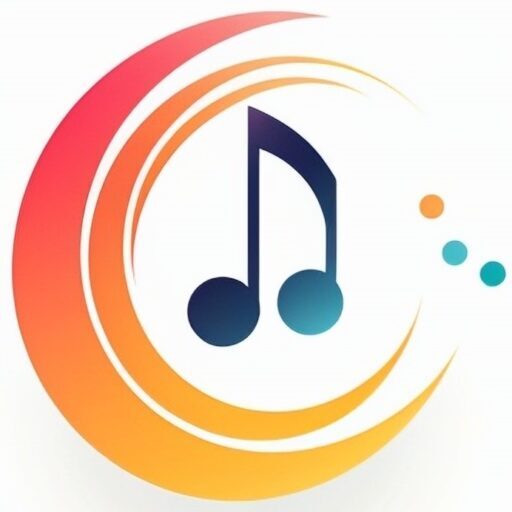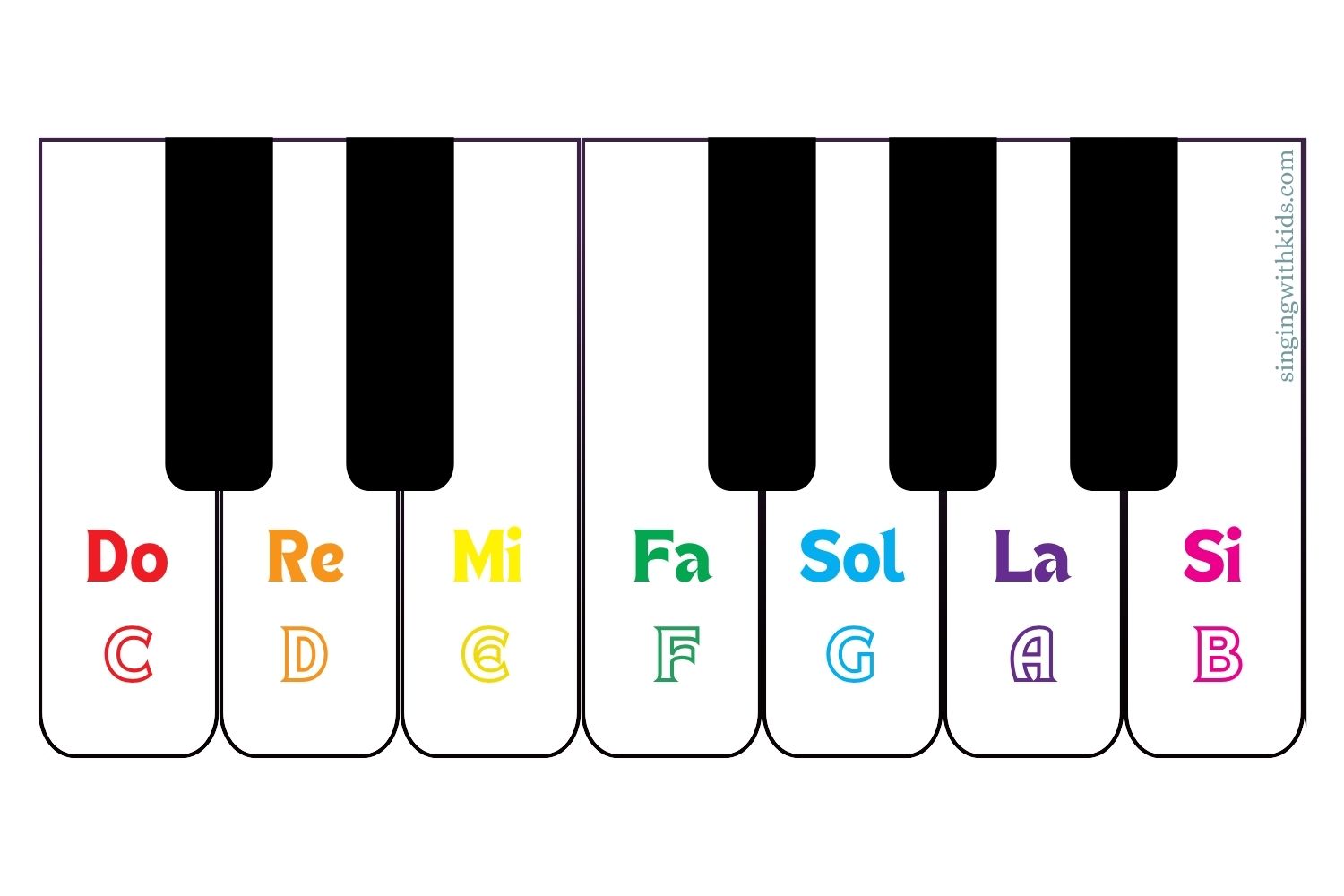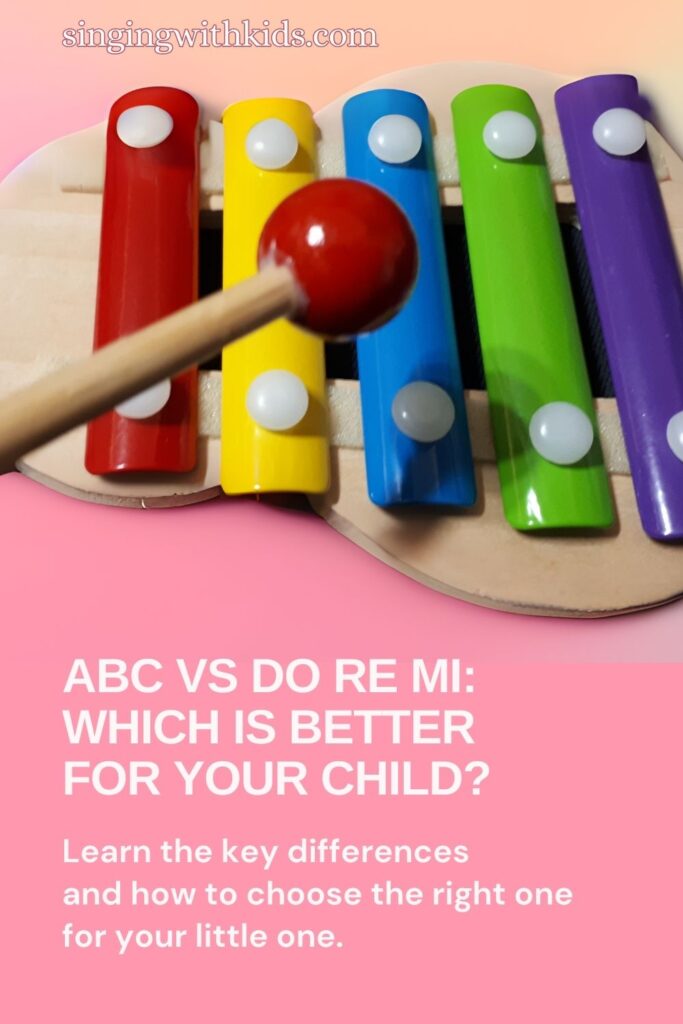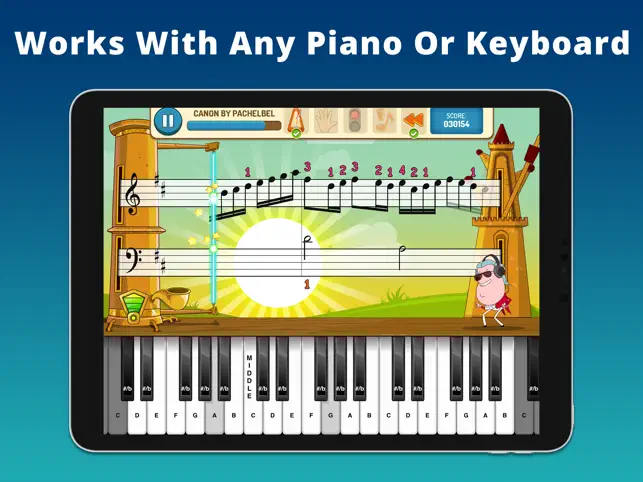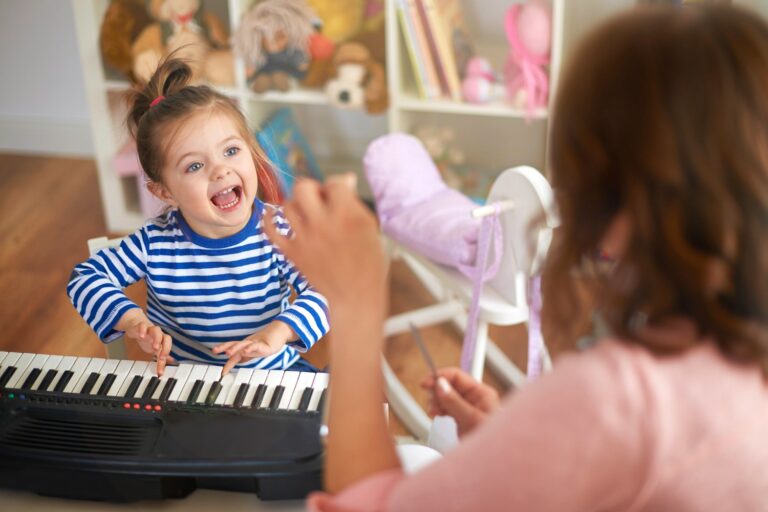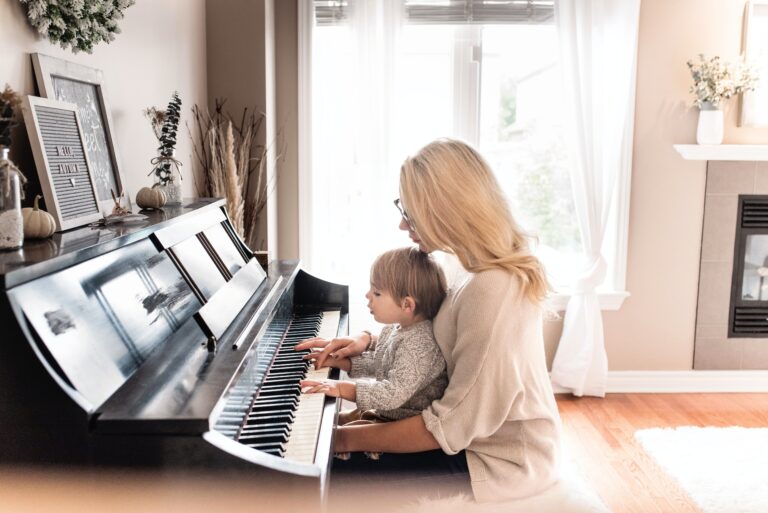ABC vs Do Re Mi: A Simple Guide for Parents
Table of Contents
The Importance of Music for Children
Music plays a vital role in a child’s development. It not only brings joy and entertainment but also fosters creativity, enhances learning skills, and builds confidence. Through music, children can express their emotions, develop social skills, and improve their memory and concentration. Whether it’s tapping their feet to a rhythm, singing a favorite song, or playing a simple tune on an instrument, engaging with music can be a delightful experience for a child.
Explanation of the Common Terms ABC and Do Re Mi
When it comes to teaching music to children, two commonly used terms are ABC and Do Re Mi. These might sound like just letters and syllables, but they represent two distinct approaches to understanding music.
- ABC Notation: This refers to the alphabetical naming of musical notes used in Western music. The letters A through G represent the seven main musical notes.
- Do Re Mi (Solfege): Also known as solfege, Do Re Mi is a system of musical education where syllables are used to represent musical pitches. It’s a widely used method for teaching sight-singing and helps to understand musical scales.
Both ABC and Do Re Mi offer unique ways to explore music, and understanding them can help parents guide their children through their musical journey.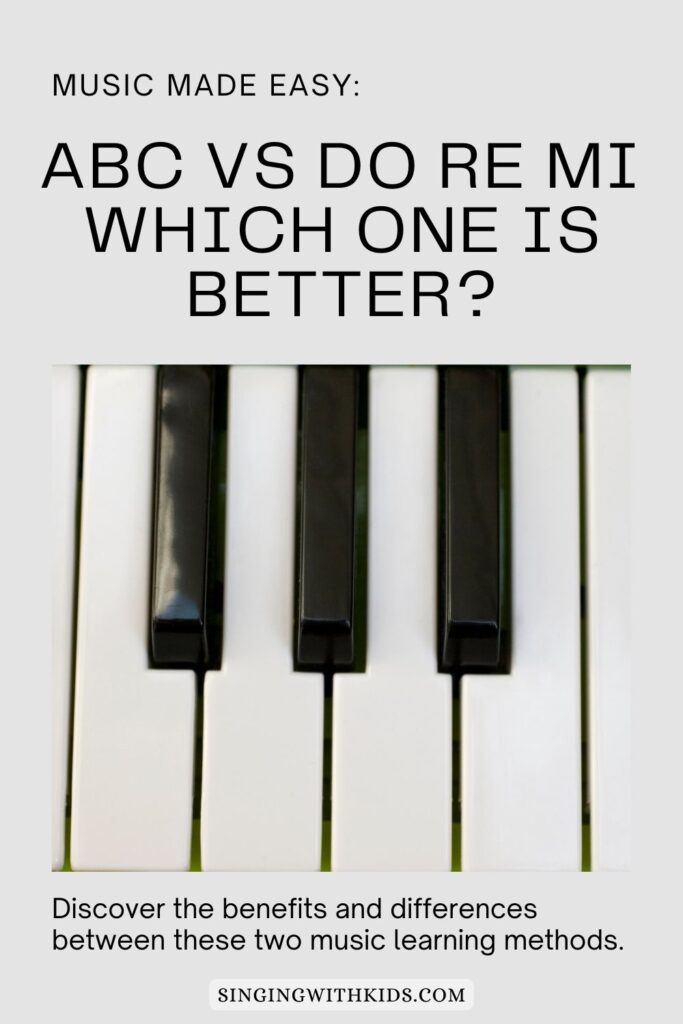
Purpose of the Blog Post
The aim of this blog post is to provide a simple and clear guide for parents, especially those without a musical background, to understand ABC and Do Re Mi. Whether your child is showing interest in singing, playing an instrument, or simply enjoys humming along to tunes, this guide will help you explore these two approaches. We will delve into what they are, how they differ, how you can teach them to your child, and what’s more beneficial for singing or playing instruments. By the end of this post, you’ll have practical insights to make informed decisions about your child’s musical learning and have fun with it too!
Through a blend of easy-to-follow explanations, expert insights, and fun activities, this guide seeks to make the world of music more accessible and enjoyable for both you and your child. Let’s begin this exciting musical adventure together!
What are ABC and Do Re Mi?
ABC Notation
Definition and Origin
ABC notation is a simple way to write music using text. It uses the letters A through G to represent the seven main notes of a scale. The system originated in the early 1990s and was designed to be easy to read and write, even for those without formal music training. It has since become a popular way to share folk and traditional tunes, particularly online.
Use in Western Music Notation
In the context of Western music notation, the ABC system correlates with the seven main notes used in most music scales. The letters A through G are assigned to specific pitches, and additional symbols can be used to denote aspects like rhythm and octave. It offers a straightforward way to write music, particularly for stringed instruments like the guitar and violin. ABC notation is especially useful for beginners and those who may not read traditional music notation easily.
Examples in Common Songs
ABC notation can be applied to almost any melody. Here are a few simple examples:
- “Twinkle, Twinkle, Little Star”: Begins with the notes C-C-G-G-A-A-G.

From ABC to melody: Simplifying music learning with familiar tunes and clear notation. - “Mary Had a Little Lamb”: Starts with the notes E-D-C-D-E-E-E.

- “Jingle Bells”: Begins with the notes E-E-E-E-E-E-E-G-C-D-E
- “Happy Birthday”: Opens with the notes G-G-A-G-C-B.
These well-known tunes can be played or sung using ABC notation, making it easier for parents and children to enjoy music together. Many resources are available online to find the ABC notation for other popular songs, providing a fun and accessible way to engage with music.
Understanding ABC notation is like learning a new alphabet for music. It’s a gateway to explore melodies, rhythms, and tunes, both familiar and new. By introducing this notation to your child, you can ignite their musical curiosity and creativity in a way that’s easy to grasp and enjoy.
Do Re Mi (Solfege)
Definition and Origin
Do Re Mi, or solfege, is a system of musical education that assigns specific syllables to each note of a musical scale. The seven main syllables are Do, Re, Mi, Fa, Sol, La, and Si, representing the major scale. The concept of solfege has roots dating back to the 11th century, and it was popularized by the music theorist Guido of Arezzo. It is a fundamental tool used by singers and musicians to learn melodies and pitches.
In our exploration of Do Re Mi (Solfege), it’s important to note that there are two main systems: “movable do” and “fixed do.” In the movable do system, the syllable ‘Do’ represents the first note of any major scale, changing based on the key of the piece. Conversely, the fixed do system assigns the syllable ‘Do’ to the note C, ‘Re’ to D, and so on, regardless of the key signature. While both have their merits, to keep things straightforward, this post focuses on the fixed do system. This approach is widely used in prestigious music institutions in the United States, such as The Juilliard School in New York City, the Curtis Institute of Music in Philadelphia, the Eastman School of Music in Rochester, New York, and the Cleveland Institute of Music in Cleveland, Ohio. By concentrating on the fixed do system, we aim to provide a clear and simple foundation for parents and children beginning their musical journey.
Use in Singing and Ear Training
Solfege is widely used for singing and ear training. The syllables help singers learn to pitch notes accurately and understand the relationships between different notes in a scale. By singing the syllables in order, a student can learn to recognize and reproduce specific intervals and melodies. Many music teachers use solfege to help students develop their musical ear, enabling them to hear and sing music more accurately.
Examples in Popular Melodies
You might be surprised to find that many popular melodies can be sung using the Do Re Mi syllables. Here are a few examples:
- “Do-Re-Mi” from The Sound of Music: A song that actually teaches solfege! The lyrics provide a fun and engaging way to learn the syllables.
- “Twinkle, Twinkle, Little Star”: Sung as Do-Do-Sol-Sol-La-La-Sol.
- “Mary Had a Little Lamb“: Sung as Mi-Re-Do-Re-Mi-Mi-Mi.
These examples illustrate how the Do Re Mi system can be applied to songs your child likely already knows, making it an approachable way to introduce music education.
Solfege is more than just a sequence of fun sounds; it’s a powerful learning tool that lays the foundation for understanding music. Whether your child is singing in a choir or humming along to the radio, Do Re Mi offers an engaging and intuitive way to connect with music. By exploring this method, you’re opening the door to a deeper appreciation and enjoyment of music that can last a lifetime.

How are ABC and Do Re Mi Different?
Comparison of Notation Styles
- ABC Notation: This method uses the letters A through G to represent musical notes, making it akin to reading and writing an alphabet. It is text-based and often used to write down melodies.
- Do Re Mi (Solfege): Solfege utilizes specific syllables (Do, Re, Mi, etc.) to signify musical pitches. It is more focused on sound and is often used for vocal exercises and ear training.
The main difference lies in the fact that ABC is more visual and text-based, while Do Re Mi is more auditory and relies on hearing and singing.
Use in Different Musical Contexts
- ABC Notation: Commonly used for playing instruments, particularly stringed instruments. It’s a handy tool for those who may not read traditional music notation.
- Do Re Mi: Primarily used for singing and teaching vocal music. It helps singers understand the relationships between notes and is central to many vocal training methods.
ABC tends to be more suitable for instrumental music, while Do Re Mi is geared towards vocal music and ear development.
Importance in Music Reading vs. Ear Training
- ABC Notation: More focused on music reading and writing, providing a straightforward way to document melodies. It can be useful for beginners learning to play an instrument.
- Do Re Mi: More related to ear training, helping students recognize and reproduce specific musical intervals and melodies by ear. It is a core tool in developing aural skills in singers.
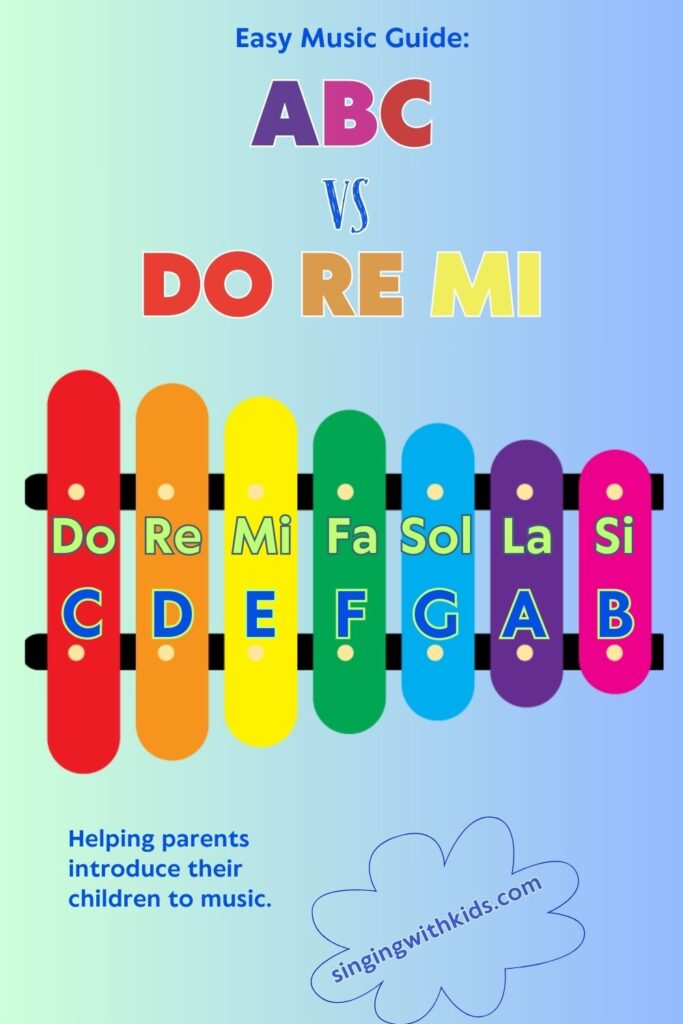
The choice between ABC and Do Re Mi may depend on whether the emphasis is on reading music (ABC) or developing listening skills (Do Re Mi).
Which is More Common in the USA and Canada
- ABC Notation: Widely used in folk and traditional music communities, and also in music education for young children and beginners.
- Do Re Mi: Often found in vocal training and choir practice, it is a part of many school music programs.
Both systems are prevalent in the USA and Canada but are used in different contexts. ABC might be more common in instrumental settings, while Do Re Mi is a staple in vocal music education.
ABC and Do Re Mi serve different purposes in the musical landscape. ABC notation is more about reading and writing music, suited to playing instruments, whereas Do Re Mi is centered around singing and ear training. Depending on your child’s interest in playing an instrument or singing, you might choose to explore one over the other, or even both, as they provide complementary skills. Understanding these differences can help you make more informed choices in supporting your child’s musical growth.
How Can You Teach Them to Your Child?
Teaching ABC
Resources and Tools
Teaching ABC notation to your child can be a fun and rewarding experience. Here’s how you can get started:
- Books and Online Tutorials: Many beginner music books and online tutorials use ABC notation to teach the basics of music. Look for materials designed for children, as they often include colorful illustrations and engaging activities.
- Music Apps: Several educational apps are designed to teach ABC notation through interactive games and exercises. These can be a great way to keep your child entertained while learning.
- Instruments: Simple instruments like a keyboard, xylophone, or recorder can make learning ABC notation more hands-on and fun. They often have note labels that correspond with ABC notation. Color-coding the notes might also help.
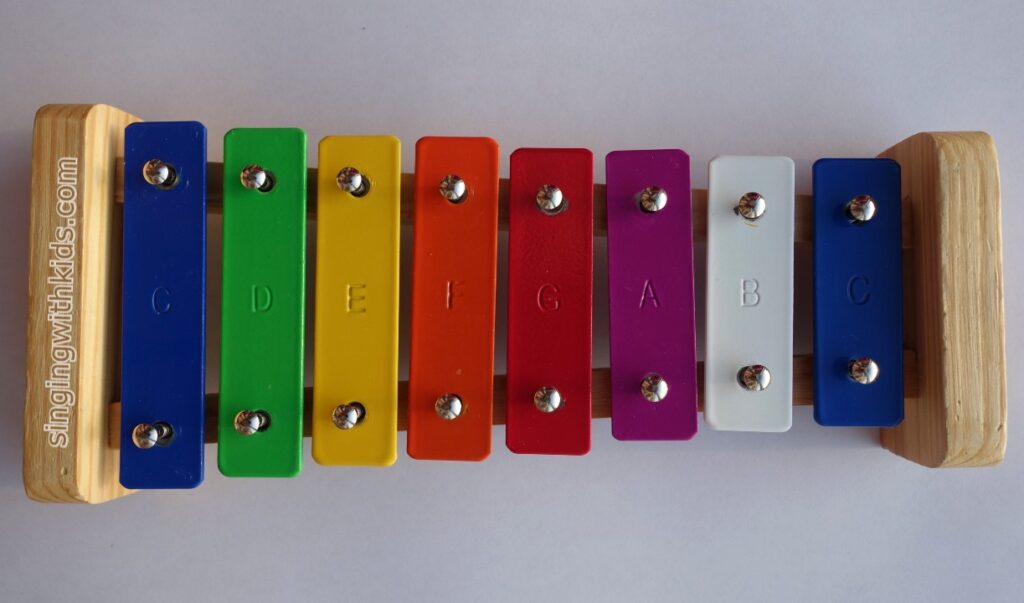
Where music meets the alphabet: Discovering notes through the ABCs on a xylophone. Image: Singing With KIds
Simple Exercises and Songs
Starting with simple exercises and familiar songs can make the learning process enjoyable:
- Note Recognition Games: Play games that help your child match the letter names to the correct sounds. Create flashcards with the letters A through G, and have your child match them to the corresponding keys on a keyboard or notes on a staff. You can use flashcards or an app for this.
- Starting with Familiar Songs: Use well-known children’s songs like “Twinkle, Twinkle, Little Star” or “Mary Had a Little Lamb.” and show them how the ABC notation corresponds to the melody they know. Break down the melody into ABC notation, and help your child play or sing it.
- Scale Singing: Teach your child to sing the major scale using ABC, going up and down.
- Encouraging Creativity: Let your child experiment with creating their own simple tunes using ABC notation. It can spark creativity and reinforce learning.
Tips for Non-Musical Parents
For parents who are less experienced in music, teaching your child ABC notation might at first appear a little overwhelming. Here are some tips to make the process smoother:
- Start Slow: Begin with just a few notes and gradually introduce more. Avoid overwhelming your child with too much information at once. Learn basics first and gradually build up to more complex songs and exercises.
- Use Visual Aids: Visual aids like color-coded keys or diagrams can make it easier for your child to understand the relationship between the letters and notes.
- Seek Professional Help if Needed: If you find that your child is particularly interested in music, consider enrolling them in lessons with a professional music teacher who can introduce ABC notation in an age-appropriate manner and provide structured guidance.
- Enjoy the Process: Remember, the goal is to foster a love for music and have fun. Be patient, and celebrate every little achievement with your child.
- Keep It Fun: Focus on enjoyment rather than strict rules. Use games, singing, and play to make learning music a joyful experience.
- Patience and Encouragement: Your positive attitude and encouragement can make a big difference. Celebrate their achievements, no matter how small, and be patient with their progress.
Teaching ABC notation to your child doesn’t require you to be a music expert. With the right tools, simple exercises, and a playful approach, you can introduce this system in a way that’s both educational and enjoyable. The key is to make music learning a fun and engaging activity that fosters your child’s curiosity and creativity. Whether it’s through singing familiar tunes, playing on a toy instrument, or experimenting with a music app, ABC notation can be a stepping stone to a lifelong appreciation of music.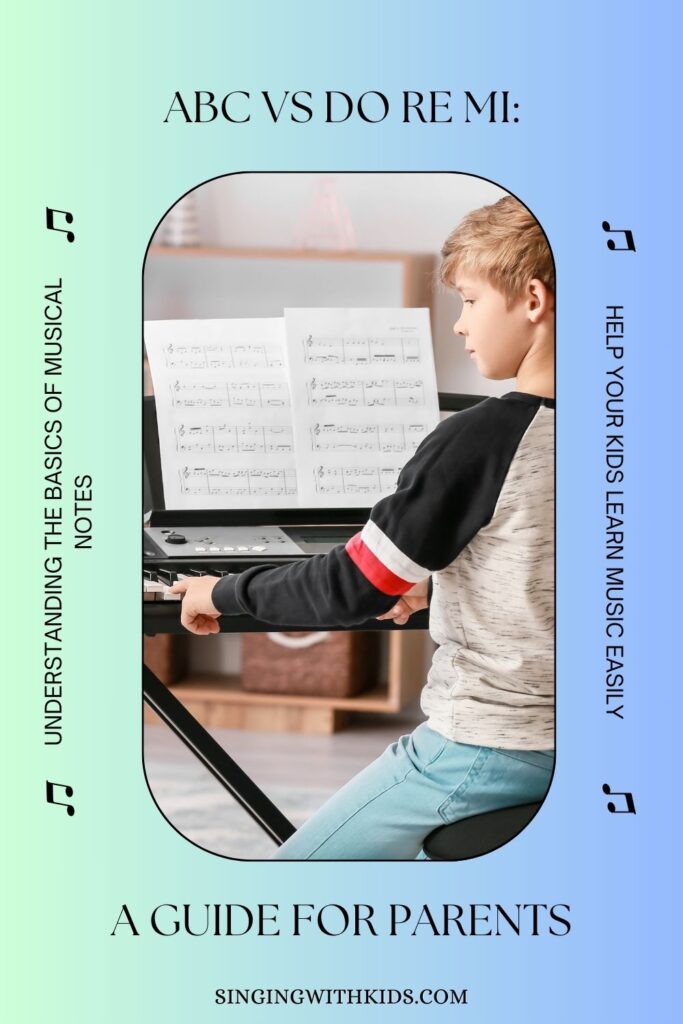
Teaching Do Re Mi
Resources and Tools
Teaching Do Re Mi is an exciting way to introduce your child to singing and ear training. Here are some useful tools to get started:
- Singing Books and Online Courses: Look for materials specifically designed for children, which often include fun songs and activities using Do Re Mi.
- Educational Apps: Several apps are designed to teach solfege through games and interactive lessons. These can provide a playful way to learn.
- Visual Aids: Color-coded charts or posters that represent the Do Re Mi syllables can be helpful for young learners.
Simple Exercises and Songs
Here are some simple and engaging exercises to help your child learn Do Re Mi:
- Singing Along to Familiar Songs: Start with songs they know, like “Twinkle, Twinkle, Little Star,” and teach them to sing it using Do Re Mi syllables.
- Scale Singing: Teach your child to sing the major scale using the Do Re Mi syllables, going up and down. It helps them to hear the relationship between the notes.
- Create Simple Melodies: Encourage your child to come up with their own simple melodies using Do Re Mi. It can be a fun way to reinforce learning.
Tips for Non-Musical Parents
Even if you’re not a musician, you can effectively teach Do Re Mi to your child:
- Learn Together: If Do Re Mi is new to you, learn along with your child. Make it a shared adventure.
- Use Recorded Music: Play recordings of songs sung in Do Re Mi to help your child get used to the sounds.
- Be Supportive and Patient: Encourage your child, and don’t worry about perfection. The key is to make it enjoyable.
- Consider Professional Guidance: If your child shows a strong interest, you may want to consider enrolling them in vocal lessons with a teacher experienced in solfege.
Teaching Do Re Mi can be a joyful and enriching experience for both you and your child. With engaging exercises, the right resources, and a supportive approach, you can foster a love for singing and help develop your child’s ear for music. Do Re Mi offers a delightful and intuitive way to explore music, and it’s a skill that can provide lifelong enjoyment and appreciation. Even if you don’t have a musical background, your enthusiasm and engagement can make all the difference in your child’s musical journey.
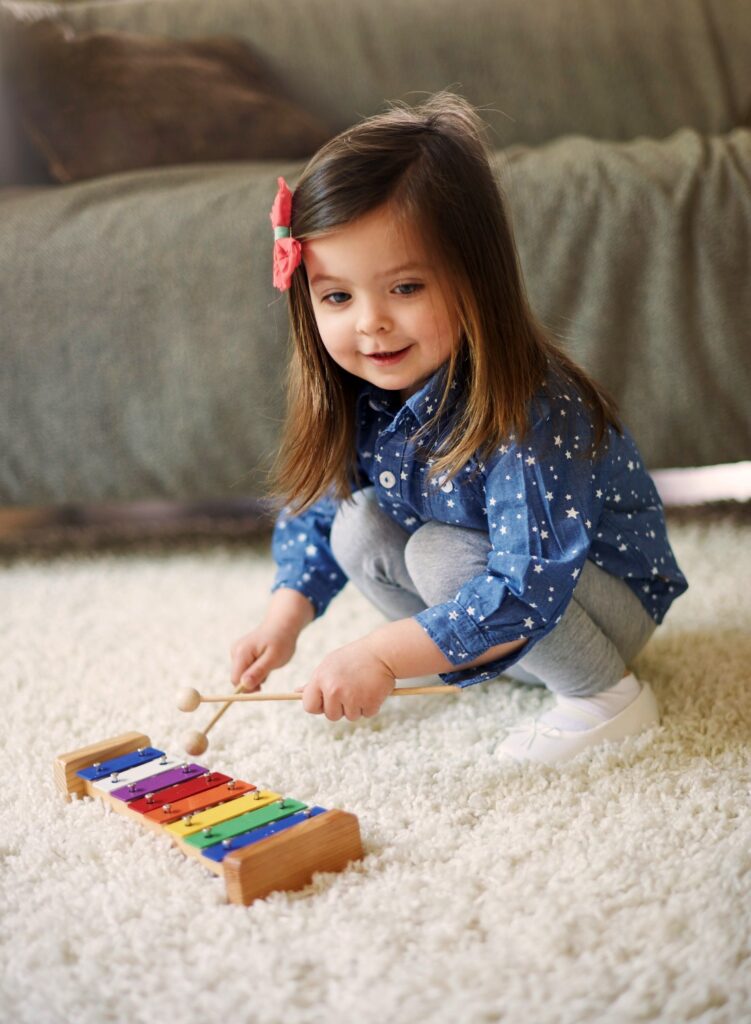
Which One is Better for Singing or Playing Instruments?
ABC for Playing Instruments
Benefits and Reasons
ABC notation provides a straightforward and practical way to learn and play instruments. Here are some of the key benefits and reasons why it’s commonly used:
- Ease of Understanding: Since ABC notation uses the letters A through G, it’s often more relatable for beginners, especially children, as it connects with the regular alphabet.
- Broad Application: ABC notation can be applied to various instruments, making it a versatile tool for learning different types of music.
- Great for Self-Learners: For those learning an instrument without formal training, ABC notation can be a more accessible entry point.
- Encourages Reading Music: It helps learners to start reading music by recognizing lettered notes on the musical staff.
Instruments where ABC is Commonly Used
ABC notation is commonly used with various instruments, particularly those suited to beginners or used in folk traditions:
- Keyboard and Piano: Many beginner piano books use ABC notation to help students learn the notes and basic melodies.
- Guitar: ABC notation can be used to teach basic chords and melodies, especially in folk guitar traditions.
- Recorder and Flute: These wind instruments are often taught using ABC notation in elementary music education.
- Xylophone and Glockenspiel: Often used in early childhood education, these instruments are taught using ABC notation to help young children understand the layout of notes.
ABC notation is a valuable tool for learning to play instruments, particularly for beginners and self-learners. Its simplicity and connection to the regular alphabet make it an approachable method. Whether your child is interested in playing the piano, guitar, or any other instrument, ABC notation offers a practical way to start their musical journey. It not only lays the foundation for playing melodies but also for understanding music reading, a skill that can be expanded upon as they grow in their musical abilities
Do Re Mi for Singing
Benefits and Reasons
Do Re Mi, or Solfege, is a cornerstone in vocal training and teaching for various reasons:
- Auditory Connection: The syllables help to connect the sound of the pitch with a specific name, aiding in pitch recognition.
- Flexibility: It can be adapted to different scales and modes, making it versatile for various types of music.
- Aids in Sight-Singing: Using Do Re Mi helps in learning to sing a piece of music by just looking at the notes, a skill known as sight-singing.
- Development of Relative Pitch: Understanding the relationships between notes in a melody is easier with the solfege system.
- Enhances Ear Training: By associating specific syllables with pitches, singers can more easily recognize and reproduce musical intervals and melodies.
- Builds Musical Intuition: Do Re Mi helps singers internalize the relationships between notes, fostering a more intuitive understanding of music.
- Versatile Learning Tool: It’s used in various musical traditions around the world and is adaptable to different musical styles and levels of complexity.
- Foundation for Music Education: Many vocal training programs, from elementary school to professional conservatories, use Solfege as a fundamental teaching method.
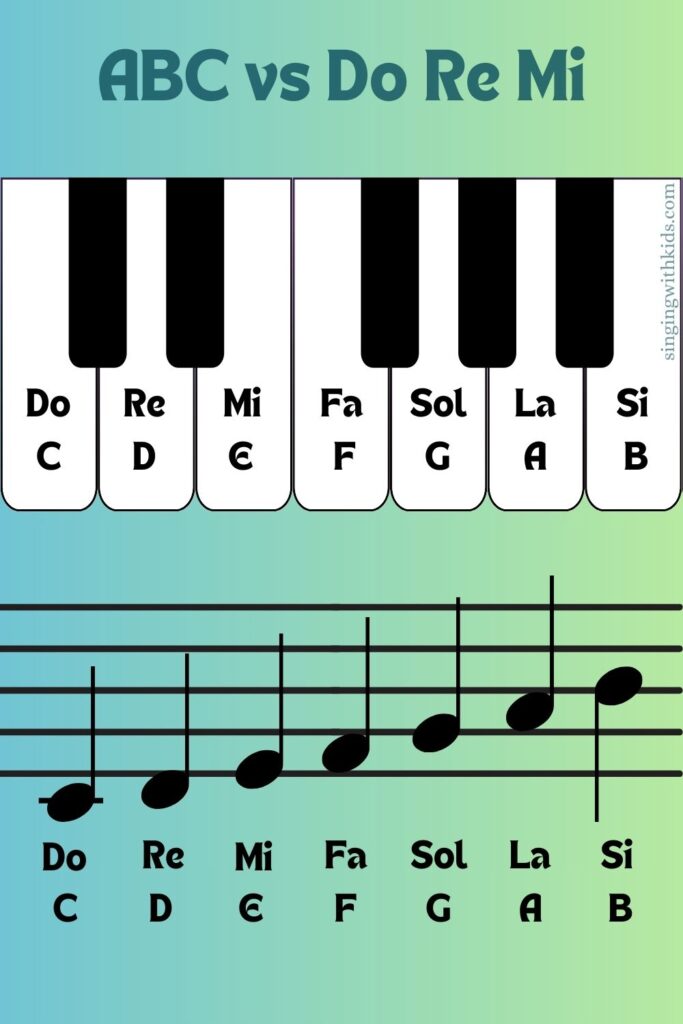
How It Helps with Pitch and Melody
Do Re Mi is invaluable in developing a singer’s sense of pitch and melody:
- Pitch Recognition: By associating each note with a specific syllable, singers can more easily identify and reproduce pitches.
- Melodic Progression: The system allows singers to understand the stepwise motion between notes, helping them sing melodies more accurately.
- Harmony Understanding: It can also aid in understanding harmonies and chord progressions within a piece of music.
- Pitch Recognition: Singing the Solfege syllables helps singers to identify and match pitches accurately.
- Melodic Understanding: Learning to sing scales and intervals using Do Re Mi helps singers understand how melodies are constructed and how to navigate them vocally.
- Harmonic Awareness: Beyond melody, Do Re Mi can also be used to teach harmonic relationships, helping singers blend with others and sing in harmony.
Professional Opinions and Research
Experts in the field of music education and vocal training widely endorse the use of Solfege:
- Widely Accepted in Education: It is commonly used in music education programs, from elementary schools to professional conservatories. Many music education organizations and teaching methods prioritize Solfege for vocal training.
- Endorsement by Professional Singers: Many professional singers and voice coaches utilize Do Re Mi as part of their training routines, highlighting its practical application in different genres of singing.
- Research Backing: Studies in music education have shown that Solfege helps develop aural skills and musical understanding more effectively than other methods.
- Professional Usage: Renowned choir directors use Solfege as a foundational tool to train voices and develop ensemble skills.
Do Re Mi is a powerful tool for anyone interested in singing, regardless of age or experience level. Its benefits extend from enhancing pitch accuracy to deepening musical understanding. Supported by professional opinions and educational research, Solfege is a time-tested method that can help singers of all levels reach their potential. Whether your child is singing in a school choir or exploring their voice at home, incorporating Do Re Mi into their training can be a key to unlocking their musical abilities.
Activities to Learn Both with Your Child
Activities for ABC
Interactive Games
Learning ABC notation through games can make the process engaging and enjoyable. Here are some examples:
- Memory Game: Create flashcards with letters A through G, and corresponding musical notes. Have your child match them in a memory game.
- Piano Key Hunt: Label piano keys with ABC letters and have your child find and play them as you call out different notes.
- Note Matching Game: Create cards with the letters A through G and match them with corresponding notes on the staff or piano keys. Turn it into a timed challenge for added excitement!
- Musical Bingo: Make bingo cards with ABC notation, and play snippets of melodies for your child to identify.
- ABC Music Puzzles: You can find or create puzzles that require matching the ABC notes to pictures of instruments or characters from favorite children’s songs.
Apps and Online Resources
Technology offers a wealth of resources for learning ABC notation:
- Piano Maestro by JoyTunes: This app has lessons that introduce ABC notation and guide children through songs using a real piano or keyboard.
- ABC Music Games: Various websites offer free ABC notation games tailored to children. They can include identifying notes, playing melodies, and more. Websites like abcnotation.com provide free tutorials and interactive lessons to help children understand ABC notation.
- YouTube Tutorials: Search for children’s music lessons on YouTube that use ABC notation. Many educators create engaging videos specifically for young learners. They often include visual aids and fun songs to sing or play along with.
Books and Offline Materials
Physical materials can also provide valuable support for learning ABC notation:
- Children’s Piano Books: Many beginner piano books for children use ABC notation to introduce basic melodies and exercises.
- Music Activity Books: Look for books with coloring pages, puzzles, and games centered around ABC notation.
- Homemade Songbook: Create a simple songbook using ABC notation for familiar songs like “Mary Had a Little Lamb” or “Hot Cross Buns.” You and your child can sing and play together using the book.
- “My First Piano Adventure” by Nancy and Randall Faber: This book series is designed for young children and uses ABC notation to teach basic piano skills.
- “Alfred’s Basic Piano Library Lesson Book” by Willard A. Palmer
- Printable Worksheets: Many websites offer free printable worksheets that use ABC notation for learning notes, rhythms, and simple melodies.
- Children’s Songbooks with ABC Notation: Look for children’s songbooks that include ABC notation. Singing or playing these songs with your child can be a delightful shared activity.
- Printable Worksheets: Many websites offer free printable worksheets that use ABC notation for learning notes, rhythms, and simple melodies.
- Children’s Songbooks with ABC Notation: Look for children’s songbooks that include ABC notation. Singing or playing these songs with your child can be a delightful shared activity.
Learning ABC notation with your child doesn’t have to be a chore. Through a blend of interactive games, technology, and traditional materials, you can turn music learning into a joyful and memorable experience. These activities not only support your child’s musical development but also provide opportunities for quality bonding time. Whether playing a game, exploring an app, or singing from a favorite songbook, these ABC notation activities will spark curiosity and foster a love for music in your child.
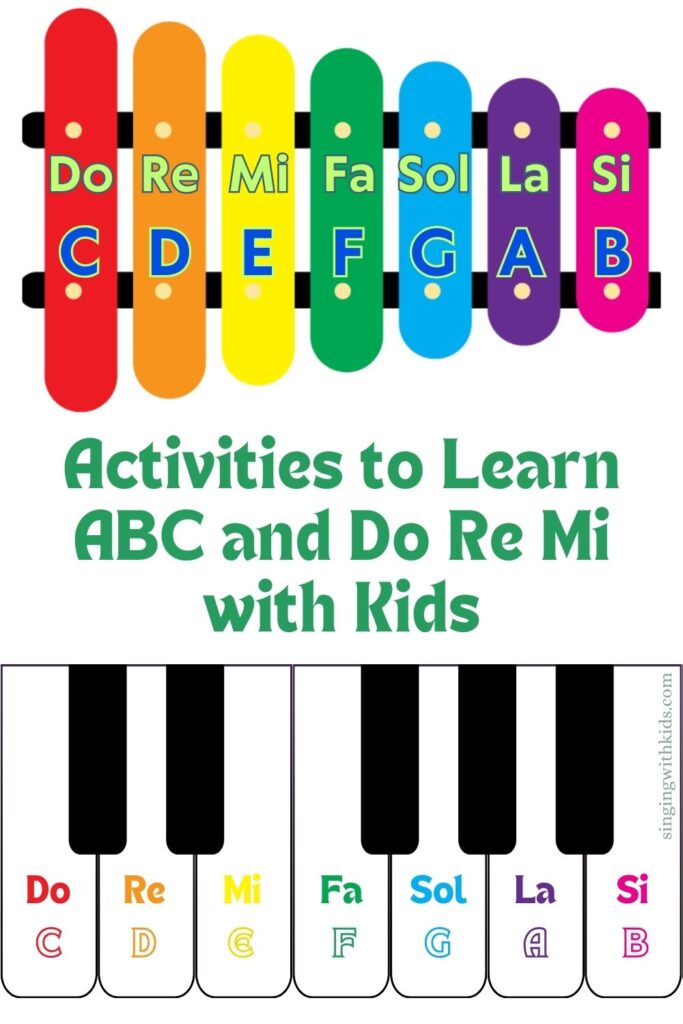
Activities for Do Re Mi
Singing Games
Using Do Re Mi in singing games can make learning a fun and interactive experience:
- Solfege Simon Says: Play “Simon Says” using Do Re Mi commands like, “Simon says sing ‘Do!'” or “Simon says sing ‘Mi, Re, Do.'”
- Do Re Mi Hopscotch: Create a hopscotch pattern with Do Re Mi syllables. As your child jumps, they sing the corresponding note.
- Build-A-Song: Together, use Do Re Mi to build a simple song, adding notes and practicing as you go.
- Musical Storytelling: Create a story using Do Re Mi as characters. Sing their “names” as you narrate the story, encouraging your child to sing along.
Apps and Online Resources
There are many tech-based tools to make learning Do Re Mi exciting:
- SolfaRead: An app that teaches sight-singing with Do Re Mi and offers interactive exercises.
- SingTrue: This app offers interactive vocal training using Do Re Mi and adapts to your child’s voice.
- Online Singing Lessons: Platforms like YouTube have singing channels that teach Do Re Mi through fun songs and engaging video content.
- Solfege Train: An app designed to teach solfege through interactive games and challenges, suitable for various age levels.
- Online Singing Lessons: Some platforms offer lessons using Do Re Mi, making them engaging with colorful visuals and interactive exercises.
- YouTube Sing-Along Videos: Look for children’s channels that offer Do Re Mi sing-along videos. Songs from “The Sound of Music” are popular choices.
Books and Offline Materials
Books and hands-on resources are also great for learning Do Re Mi:
- Solfege Songbooks: Find books with favorite children’s songs written in solfege to sing together.
- Write Your Own Melodies: Encourage creativity by writing simple melodies using Do Re Mi, and then sing them together.
- Solfege Storybooks: Some children’s books are designed around Do Re Mi, turning learning into a musical adventure.
- Do Re Mi Flashcards: Create or purchase flashcards with the Do Re Mi syllables. Use them for memory games, matching, or sequencing activities.
- Music Activity Books with Solfege: Look for books that include solfege in their music games, puzzles, and songs.
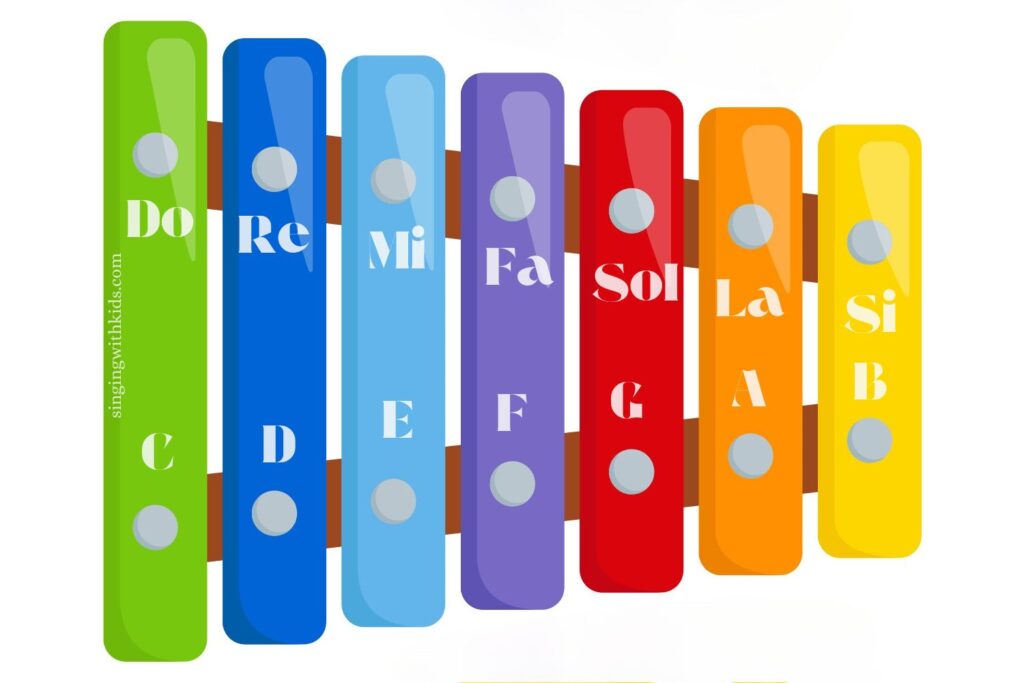
Tips to Make Learning Engaging and Enjoyable
To create a positive and fun learning environment, consider these tips:
- Start Simple: Begin with short and familiar songs to make learning easy and enjoyable. Gradually increase difficulty as your child becomes comfortable.
- Involve Their Interests: Incorporate your child’s favorite songs or themes into the activities.
- Learn Together: If Do Re Mi is new to you, learn with your child and share the excitement. Show interest in learning alongside your child. Your engagement can make the process more enjoyable.
- Be Patient and Encouraging: Praise progress and keep the atmosphere positive and relaxed.
- Mix and Match Activities: Combine different games, apps, and materials to keep learning fresh and engaging.
- Make It a Routine: Incorporate Do Re Mi into daily routines, like singing a morning song using the syllables.
- Celebrate Progress: Praise and reward your child’s progress. Small stickers or tokens can be motivating.
- Be Creative: Use your imagination to turn learning into play. The more fun you make it, the more your child will want to learn.
Teaching Do Re Mi to your child can be an enriching and enjoyable journey for both of you. With creative games, modern technology, and interactive materials, you can bring the world of solfege to life. These activities and tips are designed to provide a flexible and engaging way to explore music with your child, making learning not just educational but also fun and rewarding. Whether you have musical experience or are just starting, these resources make teaching Do Re Mi an accessible and delightful endeavor.
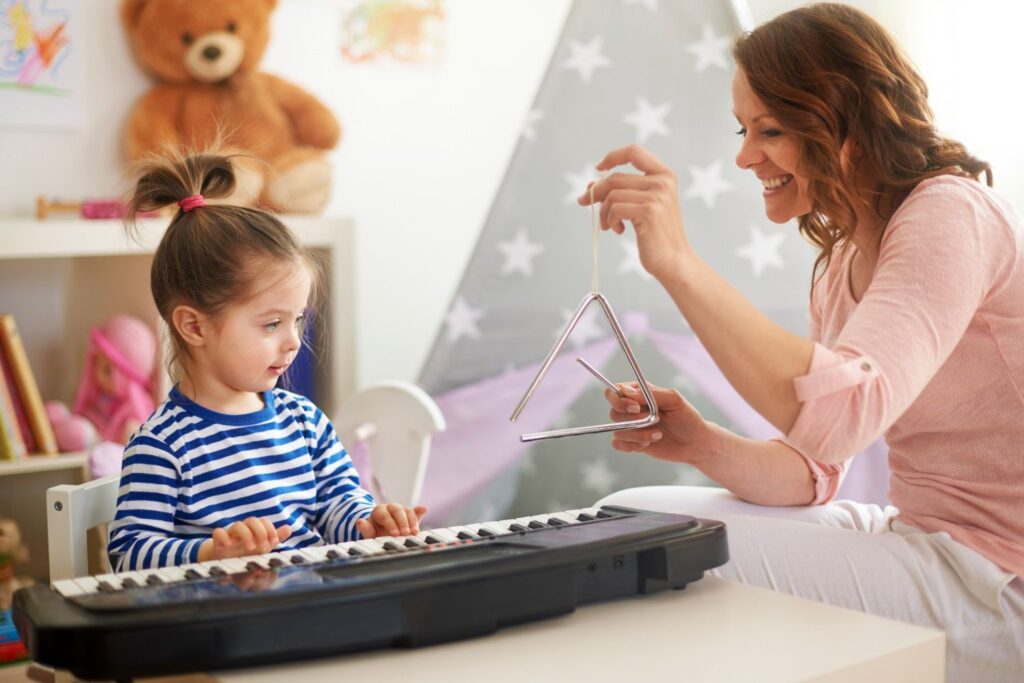
Conclusion
In this guide, we’ve explored two essential musical systems, ABC and Do Re Mi, and how they can be applied to both playing instruments and singing. We’ve seen that ABC is a versatile tool often used in Western music notation, suitable for various instruments. On the other hand, Do Re Mi (Solfege) is a powerful method for teaching singing, assisting with pitch recognition and melody reproduction. Both systems have their unique benefits, and various fun activities, resources, and tips can make learning them an enjoyable experience for your child.
Explore Both ABC and Do Re Mi
Whether your child is interested in playing an instrument or singing, exploring both ABC and Do Re Mi can provide a well-rounded musical education. Don’t be afraid to dive into these systems, even if you’re not musically inclined yourself. The activities and resources mentioned here are designed to be accessible to everyone and can turn music learning into a bonding experience with your child. Embrace the joy of music and discover how these methods can open up a world of creativity and expression for both you and your child.
Your child’s musical journey doesn’t have to stop here. Consider seeking professional guidance from a music or singing teacher who can tailor lessons to your child’s interests and abilities. Many music schools offer beginner classes in both ABC and Do Re Mi, providing a structured learning path. Alternatively, continue to explore the wealth of online resources, apps, and books available. The important thing is to keep the musical exploration alive, nurturing your child’s talent, curiosity, and love for music.
Music is a universal language that transcends barriers, and learning it can be one of the most rewarding experiences in life. Through ABC and Do Re Mi, you have two fantastic tools to start this exciting journey with your child. The world of music is vast and filled with possibilities, so why not take the first step? Let the melody guide you, and let the rhythm move you. Your child’s musical adventure awaits, and it’s yours to explore together. Happy musical journey!
